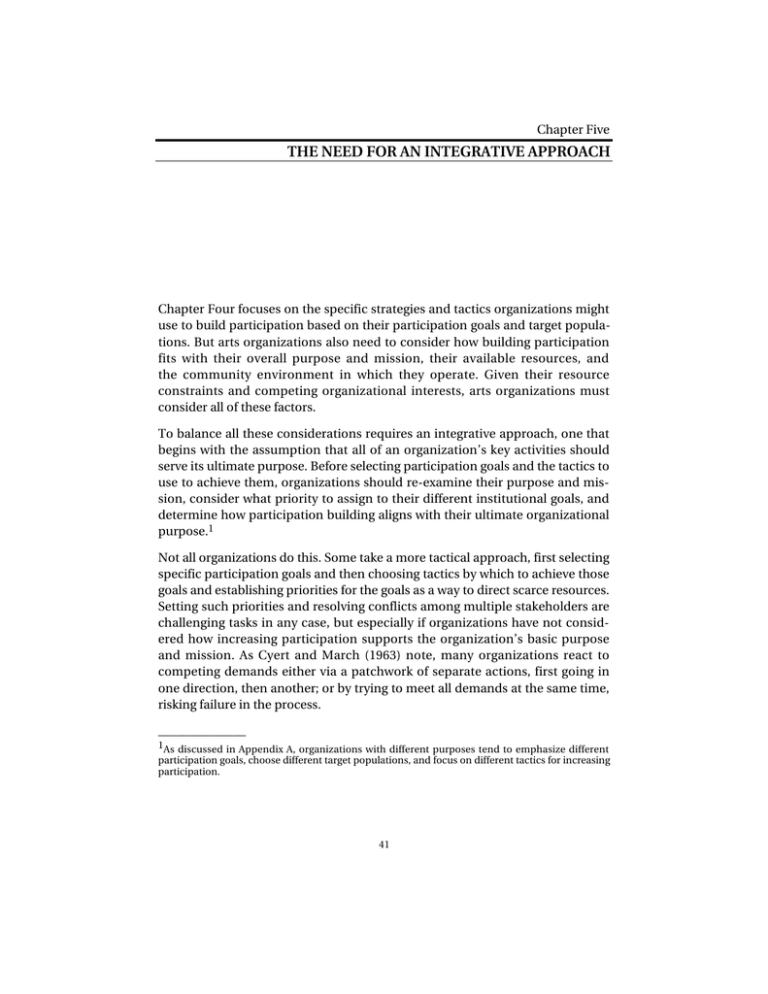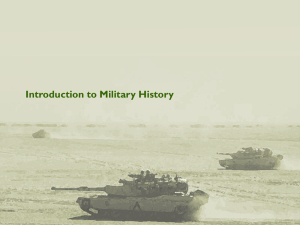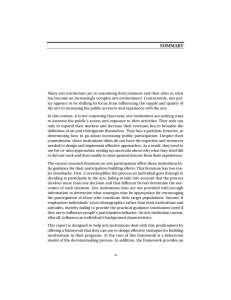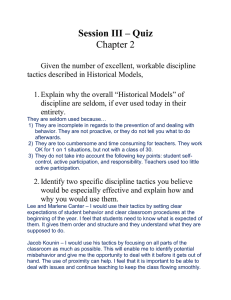THE NEED FOR AN INTEGRATIVE APPROACH
advertisement

Chapter Five THE NEED FOR AN INTEGRATIVE APPROACH Chapter Four focuses on the specific strategies and tactics organizations might use to build participation based on their participation goals and target populations. But arts organizations also need to consider how building participation fits with their overall purpose and mission, their available resources, and the community environment in which they operate. Given their resource constraints and competing organizational interests, arts organizations must consider all of these factors. To balance all these considerations requires an integrative approach, one that begins with the assumption that all of an organization’s key activities should serve its ultimate purpose. Before selecting participation goals and the tactics to use to achieve them, organizations should re-examine their purpose and mission, consider what priority to assign to their different institutional goals, and determine how participation building aligns with their ultimate organizational purpose.1 Not all organizations do this. Some take a more tactical approach, first selecting specific participation goals and then choosing tactics by which to achieve those goals and establishing priorities for the goals as a way to direct scarce resources. Setting such priorities and resolving conflicts among multiple stakeholders are challenging tasks in any case, but especially if organizations have not considered how increasing participation supports the organization’s basic purpose and mission. As Cyert and March (1963) note, many organizations react to competing demands either via a patchwork of separate actions, first going in one direction, then another; or by trying to meet all demands at the same time, risking failure in the process. ______________ 1As discussed in Appendix A, organizations with different purposes tend to emphasize different participation goals, choose different target populations, and focus on different tactics for increasing participation. 41 42 A New Framework for Building Participation in the Arts This chapter elaborates on the steps involved in taking an integrative approach to building participation and provides specific examples of how institutions have approached these steps. Our purpose is not to propose a single strategy or set of best practices for increasing participation. We believe that organizations should build participation in ways specifically tailored to their own circumstances, so what we offer is a process that can be applied in different institutional contexts. STEPS IN AN INTEGRATIVE APPROACH An integrative approach to building participation involves several steps: • Linking an organization’s participation-building activities to its core values and purpose by choosing participation goals that support that purpose. • Identifying clear target groups and basing its tactics on good information about those groups. • Understanding the internal and external resources that can be committed to building participation. • Establishing a process for feedback and self-evaluation. Linking Participation-Building Activities to Core Values and Purpose The first step is essentially equal to putting the organization’s purpose at the center of the process of developing participation goals. Successful programs require the commitment of all key staff and operating units of an organization, the board, and the network of funders. Such shared commitment must be based on the conviction that sustained audience development is critical to achieving the organization’s mission. The organization must articulate a clear set of participation goals that serve its basic purpose and mission and around which it can build consensus. Without this link, participation-building activities may be perceived as serving multiple, conflicting purposes or, even worse, as marginal to the institution’s real work. One of the major challenges facing many of the institutions we visited was how to get staff and board members united behind a common set of participation goals. Addressing this challenge often required that the institution’s mission be re-examined and the way in which the mission would be furthered by the participation goals be spelled out. Even when there was agreement on the participation goals, they sometimes were at odds with other institutional goals. For example, several organizations said that resistance surfaced among some staff and existing groups of participants when programs to attract new participants were initiated. The Need for an Integrative Approach 43 The goal-setting process needs to begin with a consideration of the organization’s purpose and mission (Shortell and Kaluzny, 1994). The important question at this early point is, How do the participation goals support the organization’s basic purpose? While virtually all of the organizations we contacted had mission statements, few had explicit statements of purpose. Purpose and mission are related but different. An organization’s purpose answers the question, Why does this organization exist? Its mission answers the question, What does this organization want to achieve? (Bart, 1986). To clarify this distinction, consider the following analogy from the world of sports. Baseball is played at several levels. At the top are major league teams, below them are several levels of minor leagues, and below these are various levels of amateur teams. There are similar team activities (or missions) at all levels. No matter what the level, for example, all teams play the same game, try to win, draw support from fans, and usually promote the communities in which they are located. However, the ultimate purpose of their activities differs. In the major leagues, the ultimate goal is likely to be earning a profit; in the minor leagues (e.g., rookie leagues funded by major league teams), the ultimate goal is to develop individual talent capable of moving up to the major leagues; and at the amateur level, the ultimate goal is likely to be the enjoyment of the participants. These differences in purpose influence a wide variety of decisions affecting how teams are organized and what priorities they attach to their different activities or missions.2. Our research revealed that the institutions we surveyed can be classified into three broad types according to their underlying purpose: • Organizations chiefly dedicated to supporting the canons of specific art forms. • Organizations chiefly dedicated to improving their communities using art as a vehicle. • Organizations serving as centers of creativity and chiefly dedicated to training new artists and engaging individuals in the creative process. These distinctions represent “ideal types” for purposes of illustration. We recognize, for example, that arts organizations cannot be neatly categorized as having a single purpose; nor will their participation goals be determined exclusively by these factors. All of the arts organizations we contacted were committed to furthering their art form, improving their community, and enhancing the lives ______________ 2Examples of this distinction between purpose and mission are contained in Appendix A. 44 A New Framework for Building Participation in the Arts of their participants. However, the priorities they attached to these purposes did differ and were often reflected in their participation goals and approaches. To clarify these differences in priorities, the following paragraphs summarize information drawn from some of our site visits. We found that organizations whose emphasis was on furthering the canons of a particular art form placed the art form at the center of their activities. As such, their greatest emphasis was on fostering an appreciation of their art form, providing opportunities for the public to experience their art, preserving and collecting existing works of arts, creating new art, and other such activities. Like all arts organizations, they were interested in increasing their participants’ involvement with their art form at all levels, but their initial emphasis was on giving individuals more exposure to their art as viewers and audience members—that is, as traditional consumers rather than as active creators. They thus tended to place higher priority on broadening and diversifying participation rather than on deepening it. In fact, increasing participation was often viewed as a vehicle for increasing the range of individuals who value the art form and improving the institution’s image as a valued and respected supplier of art. Organizations emphasizing the use of art as a vehicle for improving the community placed the community at the center of their activities. They sought not only to improve the community through art, but to increase their community’s involvement with art; to provide more community members with the opportunity to experience art; and to stress the societal, community, and other benefits of the arts. Since these institutions view the arts as a vehicle for engagement, they tended to place high priority on deepening current participation and diversifying participation to include members of the community not currently engaged in the arts. Increasing participation in both of these ways is central to their community-based mission; it also serves to validate their legitimacy within the community and is a necessary condition for fulfillment of their mission. Organizations emphasizing creativity and the creation of new art were likely to place the individual at the center of their activities. Thus, they tended to concentrate on training artists, involving individuals in the creative process, and creating new art. Because they seek to transform individuals by involving them with the creative process, they tended to emphasize deepening rather than broadening or diversifying. Indeed, arts organizations focused on creativity often try to create a one-to-one personal connection with the individual. Since the level of involvement these institutions hope to achieve often requires great commitment and trust between the organization and its participants, participants are often included in the strategic planning process. The Need for an Integrative Approach 45 Identifying Target Groups and Developing Tactics Based on Good Information Once the participation goals have been chosen, the next step is to decide on an operational plan for reaching those goals. This task involves deciding which target populations to choose, how to gather information about them, and what tactics to employ based on this knowledge. These tactical decisions involve how to gather and analyze information about the target group, what kinds of programming might attract this specific population, how best to inform the target group of the institution’s offerings, where and when to best schedule programs and other offerings for this group. The institution must also decide how the operational plan fits with the organization’s current activities. Identifying Target Groups. Before an organization chooses its target population, it should look at what it considers to be its community, or service area. It makes little sense for an institution to choose a target population not represented in its service area. The organizations we visited defined their communities of service in different ways. Some clearly defined them in primarily geographic terms. For example, Hancher Auditorium and Ballet Arizona focused their efforts on entire states; the Cleveland Museum of Art and the St. Louis Symphony Orchestra focused their efforts on metropolitan areas. Others, such as Freedom Theatre, Cal Arts, and Old Town School of Folk Music, defined their service communities mainly in terms of specific demographic groups. Still others, such as The Loft and Poet’s House, defined their service communities primarily in terms of people who share a particular behavioral characteristic, such as people who write or who love poetry. By identifying its service community, an organization can narrow the range of options it needs to consider in selecting a target population. Within any service community, however, there will be a wide range of populations that could be targeted. Organizations may use several different “prisms” to help narrow their choices. They might, for example, consider which group is the most underserved within their community or which is growing most rapidly. Or they might consider which of the three forms of participation is most important to their purpose and mission and choose their target population accordingly. For example, an organization focused on broadening participation might decide on a target population that appears to be interested in the arts but is not currently involved in its activities. And an organization focused on deepening participation might choose to target a group it believes is interested in being directly involved in the creative process. Organizations might also consider how well-aligned their current activities are with the interests of their target population. For example, an organization that offers educational 46 A New Framework for Building Participation in the Arts classes to school-age children might consider targeting parents, since those classes already provide a natural bridge to parental involvement. Learning About Target Groups. Once an organization has identified its target population, it then needs to gather information about that group. As noted in Chapter Four, organizations use various techniques for this purpose, such as surveys, focus groups, interviews, and discussions with knowledgeable community members. Whatever technique is used, information gathering is a crucial step. Institutions that identify how target populations view the arts, why they might be interested in participating, and what they consider to be major obstacles to their participation are more likely to succeed in reaching new audiences. When the Cleveland Museum of Art launched a major communityengagement initiative to reach underserved populations, it began by forming a committee to help identify and target such groups and to design outreach efforts likely to appeal to them. To choose tactics that will be effective in reaching target groups, organizations must know something both about why those groups might be inclined to participate in the arts and about the perceptual, practical, and experience barriers that may make them reluctant to act on their inclinations. Appendix B documents the fact that arts organizations identify many reasons why individuals may be interested in the arts. Some individuals are intrinsically interested in the arts in general or in a particular type of art; other individuals are attracted by the opportunity the arts provide to be part of a wider community of people sharing a common experience. Still other people are motivated by the desire to express themselves artistically or find the arts enriching; others want their families to experience the arts. Most individuals are motivated by more than one reason when they decide to engage in an arts activity. Understanding what these motivations might be and how they fit with the organization’s current programs is critical to developing effective participation-building tactics. Developing Appropriate Tactics. To address the perceptual barriers a target group might have, many organizations we interviewed developed programs and activities specifically designed to change their public image. The Cleveland Museum of Art, for example, introduced several new initiatives designed to counter its image as an “elite” institution and to broaden its appeal within the community. These initiatives included a program to bring 20 art exhibits a year into shopping centers, schools, and community centers; community-oriented programming that set aside specific days for target groups to come to the museum; informal barbecues twice a week at the museum; and an annual Mardi Gras-style parade that involved workshops on float and costume design located throughout the community. The St. Louis Symphony Orchestra instituted a community partnership program to send small groups of musicians into schools, churches, and civic organizations to perform and discuss their music. The Need for an Integrative Approach 47 Ballet Arizona added a “Dias de Los Muertos” program to attract Hispanic participants and mythology programs to attract Native American audiences. As for the practical factors, organizations need to consider those aspects of the target group’s lifestyle that will influence participation in their programs, such as how these individuals learn about cultural events and what times will best fit their schedules. Many organizations we interviewed relied on community leaders (including representatives of sports clubs) in publicizing their activities and convened community advisory councils for special events and exhibits. Some institutions advertised their activities in Spanish and other languages; others expanded their operating hours to include nights and weekends so as to fit more people’s schedules. Still others offered discounts or special coupons to attract certain participants. The experience factors that must be considered are the target group’s reaction to the programs and the institution’s atmosphere. Many organizations are trying different ways to create a more receptive environment, such as training and evaluating staff on their willingness to serve visitors, holding pre- and postprogram talks to increase participants’ understanding of and familiarity with the arts, and providing opportunities for visitors to socialize in conjunction with arts events. For example, in opening a restaurant in its new facility, Old Town School of Folk Music sought not only to raise revenues but also to make its atmosphere more comfortable and inviting, to create an opportunity to inform visitors about upcoming events, and to offer an informal place to meet and talk with visitors. Understanding the Organization’s Resources Once an organization has selected its participation goals and tactics, it needs to determine the resources that will be necessary to implement its participationbuilding strategy and how they will be obtained. This step requires the organization to take stock of its own resources in light of other institutional demands, which entails assessing all internal assets (staff, professional abilities, facilities, and equipment) and resources available in the broader community. Understanding Internal Resources. All organizations have certain basic institutional needs: hiring, training, and motivating staff; operating within budgets; self-governance; and adapting to change. Balancing the resources allocated to these various needs with those required to implement participation-building strategies can lead to tensions within the organization. In our surveys, some organizational leaders talked about tensions between those concerned with controlling expenditures on production costs and those wanting to develop pro- 48 A New Framework for Building Participation in the Arts grams that would appeal to a broad range of participants. Others mentioned tensions between marketing staff and creative directors over whether to develop programs that appeal to existing versus potential participants. In fact, concerns about friction over how programs designed to appeal to new audiences would affect existing audiences were not at all uncommon. This friction arose within the staff and sometimes between boards and staff—especially if there were already disagreements regarding the importance of building participation or the emphasis assigned to certain participation goals. Growing organizations seem to have a greater potential for such conflicts. Several of the institutions referred to the need to maintain communication and “a sense of connectedness” among the staff when an organization is growing. Internal tensions were often different depending on organization size. Large organizations in our survey, for example, often had more resources and expertise but sometimes found it difficult to get staff committed to the organization’s participation goals. In small organizations, tensions often arose over the increased workload required to build participation. Responsibility for implementing strategies and building collaborative relationships with other groups tended to fall on staff who were already overcommitted, leading several small arts organizations to use their grant funds to add staff and expertise to deal with the extra duties. The resources that an organization needs to implement its participation strategies are not limited to dollars and staff time and abilities. They also include less tangible resources, such as leadership, knowledge of target populations, and visibility and reputation in the community. Although more resources are generally preferred to fewer resources, the organizations recognized that resources considered to be assets in working with one target population could actually be a liability in working with another. For example, prestige within the community and a reputation as an elite institution may help an organization broaden the participation of individuals inclined toward the arts, but they may also serve as a barrier for those who see the institution as elitist and thus not for people like them. Many institutions noted the importance of changing their image within the community and establishing trust between themselves and their target groups. Collaborating with Other Organizations. Virtually all the organizations we contacted recognized the importance of establishing strategic alliances with other institutions and individuals within the community as a way to expand available resources. Some of these alliances were through long-established collaborations, and some were set up for specific projects or programs. Many of the organizations noted, for example, that they had established community advisory committees to help them develop programs and reach out to target The Need for an Integrative Approach 49 populations. Collaborations with artists, arts organizations, and other community organizations were also frequently developed to further participation goals. Two particularly interesting approaches to community collaborations are the Poet’s House “Poetry in the Branches” program and The Loft’s collaboration with other literary organizations. Poet’s House collaborates with the New York Public Library to advise librarians on how to build a good poetry collection, create poetry displays, and foster broader appreciation of poetry through writing workshops and poetry readings. The Loft has an agreement with several other literary organizations—a bookbinding and paper-making center (The Minnesota Center for Book Art), a small press (Milkweed Editions), and a bookstore (The Hungry Mind)—to share space in the same building. Although community collaborations are central to most organizations’ participation-building tactics, establishing a successful alliance is not an easy task, according to what we were told. The long-term effect of such collaborations may be to expand the resources available to an organization, but their development is a time-intensive process and may in the short term create more costs than benefits. Arts organizations emphasized that for collaborations to work, the missions of the collaborating organizations must be complementary and the expectations and the assets each party brings to the effort must be made explicit. Establishing a Feedback and Evaluation Process The overall task of developing participation goals and operational plans and allocating resources is unlikely to be straightforward. Organizations are apt to begin with an initial planning phase, start the implementation process, and then revisit earlier decisions armed with what they have learned from actual experiences. The final step in an integrative approach thus is to establish a process for evaluation and feedback. A thorough process for evaluating both operational plans and the progress being made in implementing them should be built in so that activities can be adjusted as the participation-building program proceeds. Such a process also assures that enough information is collected from the outset so that the organization can assess its own performance and communicate the results to various stakeholders. Moreover, such a process helps organizations realize that developing a successful program takes time and requires both sustained commitment and a willingness to modify the approach as warranted. Often this process begins with a strategic planning exercise in which the organization’s staff and board re-examine the organizational purpose and mission before they even begin to choose a set of goals and tactics. As the leadership of the Walker Arts Center explained, the development of a plan was critical to their 50 A New Framework for Building Participation in the Arts efforts: “We spent lots of time working on our plan and developed a sense of “mantra” about it—it formed our marching orders.” Beginning with this type of exercise can be an essential first step, but the resulting initial plans need to be revisited, and often they need to be modified. Organizations adopting an integrative approach to participation-building thus need to incorporate an evaluation and feedback process. A key element of the evaluation process is development of a set of measures that can be used as a benchmark in assessing progress. Virtually all of the organizations we visited described different criteria they had used to assess the success of their participation-building efforts. In choosing these yardsticks, the organizations considered two important questions: What do we mean by success? And how do we measure it? Nearly every one of these institutions looked to changes in patterns of participation as measures of success, but many also considered a broader range of indicators that provided insight into how participation affected the organization’s broader goals. Whether they focused just on changes in participation patterns or also looked at success more broadly, these organizations believed that success could not be measured strictly in quantitative terms. All of them also considered a range of qualitative measures of how well they were doing. The following discussion provides examples of how the organizations approached these evaluation tasks. When we asked the organizations how they measured the success of their participation-building efforts, virtually all of them mentioned changes in the number of participants—but this was typically just the starting point. How they measured the changes varied depending on whether the organization focused on increasing attendance (measured in number of attendees and box office receipts), involving participants in various training programs (measured in enrollments), or increasing circulation (for example, Poet’s House, which initiated a poetry outreach effort in the New York Public Library, looked at numbers of books of poetry in circulation). Most organizations also measured changes in their participants’ diversity, which entailed paying attention to the demographics of new participants and how they compared with those of prior participants and with the composition of the community. To gauge the extent to which current participants had become more deeply involved, some institutions collected information on the frequency of repeat attendance and return visits, and the degree to which occasional participants were converted to subscribers or volunteers. Sometimes this entailed upgrading record systems to keep better track of participation. Although the organizations all used quantitative measures to capture certain effects of their efforts, they all were adamant that some important effects could The Need for an Integrative Approach 51 be adequately captured only through more qualitative measures. Some assessed participants’ reactions to specific programs, including their level of engagement and level of comfort with the experience. Others looked for the degree to which the participants knew and interacted with the staff and vice versa, the number of hits on the organization’s Web site, how long individuals had been involved with the organization, or the level of community involvement with the organization, including the number of people who wanted to work at the organization. Many organizations also noticed the effects that participation building had on other aspects of their operations. They reported that building participation often contributed to broader institutional goals, such as those concerning staff morale, board involvement, and the quality and diversity of the programs they were able to offer. Several organizations, for example, mentioned the positive effects their participation efforts had on the morale of staff and artists with whom they worked. As staff and artists became more involved with participants and the communities these institutions served, their enthusiasm and satisfaction grew. Other organizations noted that their board became more involved with their work as a result of the participation initiatives. Still others mentioned that increasing participation levels helped their efforts to attract artists to work with them, which expanded both the range and the complexity of the programs they could offer. Two other indirect benefits of participation-building activities were mentioned by several organizations: they received more media coverage, and they had greater success in raising funds. Since lack of visibility and inadequate funding were rated as significant problems by many organizations, these two consequences were considered very important, not only to the success of their participation initiatives but also to fulfilling their institutional mission. ***** In sum, an integrative approach to building participation requires that arts organizations do more than just focus on their participation-building activities. They must also consider how those activities align with the institution’s purpose and mission and its available resources, as well as how that alignment will affect other organizational goals and activities. Moreover, they need to evaluate their participation-building efforts as they progress, modifying their activities as appropriate.





